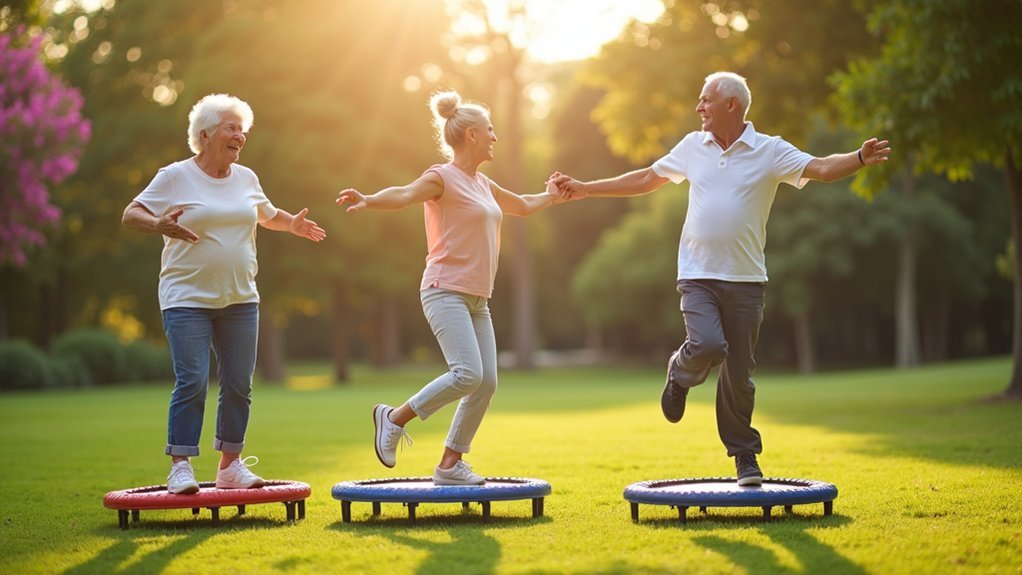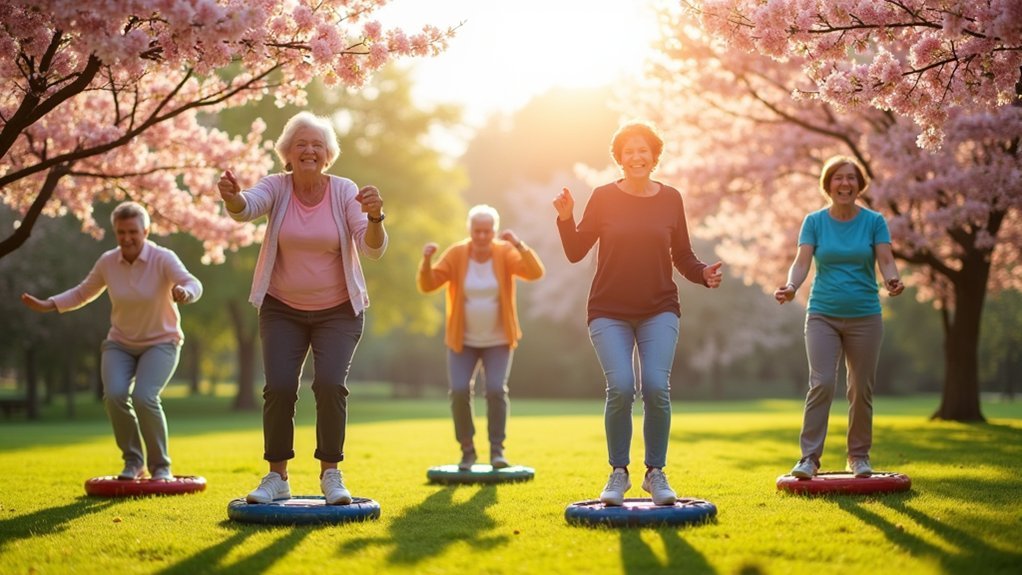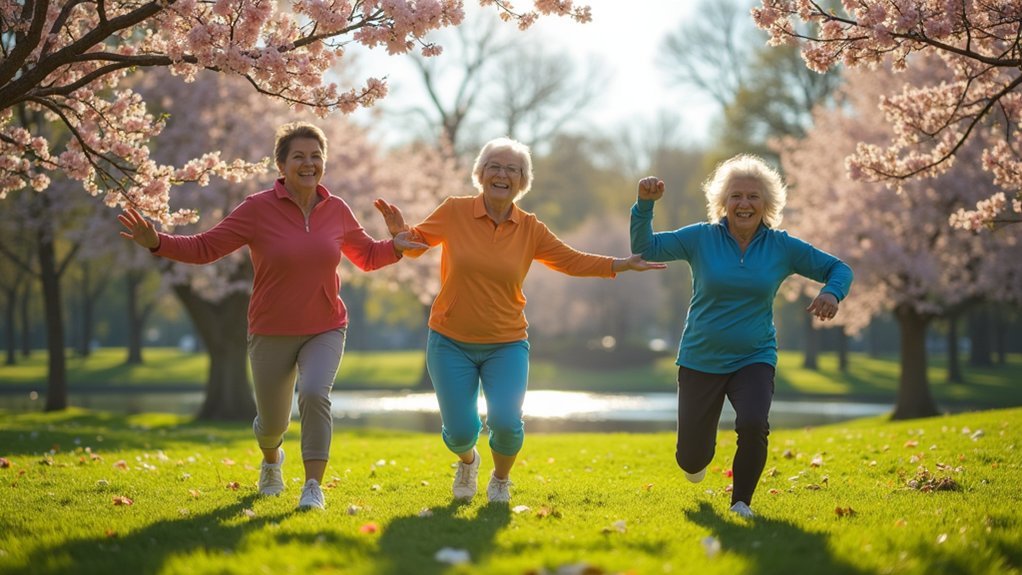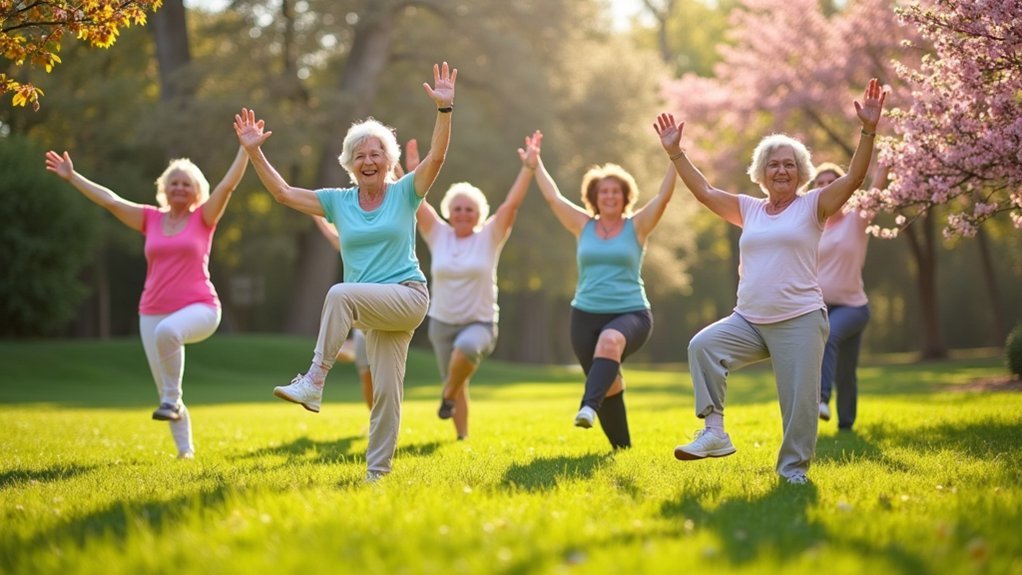Rebounding on a mini-trampoline offers seniors gentle, joint-friendly exercise perfect for spring. You’ll boost cardiovascular health while improving balance and coordination with simple routines like heel taps and seated bounces. Start with chair-assisted bouncing if you’re a beginner, then progress to outdoor sessions to enjoy fresh air. This low-impact activity also manages arthritis pain, strengthens leg muscles, and releases mood-enhancing endorphins. Discover how just 10-15 minutes three times weekly can transform your fitness journey.
Gentle Morning Rebounding Warm-Ups for Joint Health

While many seniors hesitate to try rebounding, gentle bouncing on a mini-trampoline offers remarkable benefits for aging joints. Just 10-15 minutes each morning can greatly improve your joint health by promoting fluid movement and reducing stiffness.
This low-impact activity doesn’t just strengthen joints—it activates your lymphatic system, helping flush toxins and improve circulation throughout your body.
For seniors concerned about stability, rebounding actually enhances balance and coordination, vital skills for preventing falls and maintaining independence.
You’ll likely notice an improved mood too, as these gentle exercises release mood-boosting endorphins.
The best part? Rebounding can be modified for any fitness level, making it accessible for most seniors. Hold onto a support if needed while you bounce gently to start.
Low-Impact Bounce Routines for Cardiovascular Fitness
Although many seniors focus on strength training, cardiovascular health remains equally important as you age. Low-impact bounce routines on mini-trampolines offer an ideal solution, boosting heart health without stressing your joints. Just 15-20 minutes of rebounding releases mood-enhancing endorphins while improving your balance and coordination.
| Routine | Benefit | Time |
|---|---|---|
| Gentle Bounce | Improves circulation | 5 min |
| Heel Taps | Enhances gentle balance | 5 min |
| Seated Bounces | Supports joint health | 5 min |
What makes these exercises particularly valuable is their adaptability. You’ll find low-impact bounce routines can be modified to match your fitness level, ensuring staying active remains safe and enjoyable. The cardiovascular fitness benefits combine wonderfully with muscle toning, helping maintain your independence and mobility.
Balance-Building Rebounding Exercises for Fall Prevention

Three critical factors make rebounding exercises essential for seniors concerned about falls: improved stability, enhanced proprioception, and strengthened leg muscles.
When you bounce gently on a mini-trampoline for just 10-15 minutes three times weekly, you’re training your body to better sense its position in space.
These balance-building exercises don’t just prevent falls—they simultaneously support your heart health through cardiovascular benefits without stressing your joints.
Balance training through gentle rebounding offers dual protection—preventing falls while nurturing heart health without joint strain.
You’ll notice improved confidence in your movements as your coordination develops and muscle tone increases.
The beauty of rebounding lies in its gentle nature while delivering powerful results.
Chair-Assisted Rebounding for Beginners
Four simple steps can transform rebounding into a safe, accessible exercise for seniors who need extra support. First, position a sturdy chair next to your mini-trampoline for balance. Second, start with gentle, seated bounces for just 5-10 minutes. Third, listen to your body and gradually increase duration as your comfort improves.
Chair-assisted rebounding offers impressive health benefits without stressing your joints. You’ll enhance cardiovascular health, improve circulation, and strengthen leg and core muscles while boosting flexibility for daily activities.
This low-impact exercise also releases mood-enhancing endorphins, making senior fitness enjoyable rather than obligatory. As you stay active with this gentle bouncing routine, you’ll notice improvements in muscle tone and energy levels—perfect for embracing an active lifestyle this spring.
Springtime Outdoor Rebounding in Nature

Embrace the renewal of spring by practicing gentle balance exercises on nature’s uneven terrain, which naturally strengthens your stabilizing muscles and improves coordination.
You’ll find that natural settings offer resistance training opportunities through activities like walking on sandy paths or traversing gentle slopes that tone muscles without straining joints.
The vibrant spring backdrop not only elevates your mood but also creates a perfect environment for mindful movement practices that enhance your body awareness and reduce fall risk.
Outdoor Balance Activities
While indoor exercises offer comfort and convenience, stepping outside during spring offers seniors a rejuvenating opportunity to improve balance amid nature’s awakening landscape.
Outdoor balance activities like tai chi and gentle yoga can enhance your stability while you enjoy fresh air and scenic surroundings.
Research shows tai chi can reduce fall rates by up to 47%, making it an excellent choice to improve your balance.
Try walking on uneven park trails to challenge proprioception or practice single-leg stands in your garden to strengthen lower body muscles. These exercises build confidence in movement and support independence.
Join community balance classes to connect with others while boosting your physical health. The combination of social interaction, nature, and purposeful movement creates a holistic approach to wellness that indoor environments simply can’t match.
Nature-Based Muscle Toning
Beyond balance exercises, spring offers the perfect backdrop for gentle muscle toning activities that capitalize on nature’s rejuvenating energy.
Rebounding outdoors on a mini-trampoline provides a low-impact exercise that strengthens multiple muscle groups while protecting your joints. You’ll enjoy improved cardiovascular fitness and muscle strength as you bounce in scenic surroundings.
Try these nature-based muscle toning options:
- Combine 10-minute rebounding sessions with nature walks to maximize benefits of exercise while enjoying fresh spring air.
- Join outdoor group rebounding classes to build social connections while improving your balance and flexibility.
- Schedule morning rebounding routines to boost mood-enhancing endorphins that contribute to your overall well-being.
This spring, discover how nature-based muscle toning can transform your fitness journey with enjoyable, effective workouts.
Strength-Building Mini Trampoline Movements
Bounce your way to better health with mini trampoline exercises, a perfect low-impact option for seniors seeking to maintain their independence.
These gentle exercises strengthen your core and leg muscles while being kind to your joints. Just 10-15 minutes a few times weekly offers numerous health benefits for older adults, including improved balance and coordination.
The rhythmic bouncing motion engages multiple muscle groups simultaneously, helping to counteract age-related muscle loss.
You’ll notice improved cardiovascular health with regular practice, and the natural endorphin release provides a welcome mood boost.
Best of all, mini trampoline workouts can be easily modified to match your fitness level, making them accessible regardless of your current abilities.
You’ll reduce fall risk while enjoying a fun, effective way to stay active.
Flexibility-Enhancing Rebounding Stretches
As you explore rebounding exercises, flexibility-enhancing stretches on your mini trampoline offer exceptional benefits beyond strength training.
These gentle movements improve joint mobility without straining your body, while simultaneously stimulating blood circulation and lymphatic flow—crucial elements for your recovery and overall health.
The low-impact nature of rebounding makes it perfect for seniors, providing effective workouts with minimal injury risk.
Just 10 minutes daily can transform your:
- Muscle tone and coordination, reducing fall risks
- Balance and strength, enhancing stability for daily activities
- Blood circulation, promoting faster recovery and better health
Group Rebounding Activities for Social Wellness
Three remarkable benefits emerge when you join group rebounding activities – physical health improvements, emotional wellness, and social connection. Even just 10-15 minutes on mini-trampolines releases mood-boosting endorphins, enhancing your mental health while keeping you steady on your feet through improved balance.
| Benefit | How It Helps |
|---|---|
| Low Impact | Minimizes joint stress while building strength |
| Social Interaction | Reduces loneliness through peer encouragement |
| Adaptability | Accommodates all fitness levels safely |
The music and fun routines make your exercise program enjoyable rather than a chore. You’ll find yourself looking forward to sessions where you can challenge yourself at your own pace while connecting with others. This combination of physical activity and social engagement creates a sustainable wellness practice that benefits both body and mind.
Therapeutic Rebounding for Arthritis Management
Therapeutic rebounding offers you a gentle, low-impact way to relieve arthritis pain while simultaneously improving your balance through consistent mini-trampoline sessions.
You’ll notice enhanced circulation as the bouncing motion stimulates your lymphatic system, helping reduce inflammation in affected joints.
Your arthritis management routine can benefit greatly from this accessible exercise that boosts blood flow without straining sensitive joints.
Low-Impact Joint Relief
When stiff joints and arthritis pain limit your mobility, a mini-trampoline might be the surprising solution you haven’t considered. This gentle form of exercise, known as therapeutic rebounding, offers seniors significant joint relief without the harsh impact of traditional workouts.
Just 10-15 minutes of daily bouncing can transform your arthritis management routine:
- Improved circulation – The rhythmic bouncing enhances blood flow and stimulates your lymphatic system, reducing inflammation in painful joints.
- Natural pain relief – Your body releases endorphins during rebounding, providing a natural way to manage discomfort.
- Customizable intensity – You can start with simple, low-impact movements and gradually increase difficulty as your strength improves.
Best of all, rebounding strengthens your body while being kind to your joints.
Balance Improvement Benefits
Balance emerges as a key benefit from your rebounding routine, extending well beyond joint relief. As you gently bounce on the mini-trampoline, you’re actively enhancing your proprioception—your body’s ability to sense its position in space—which is vital for preventing falls.
This low-impact exercise strengthens the stabilizing muscles needed for better balance while being gentle on arthritic joints. You’ll notice improved coordination with regular sessions as your body adapts to the dynamic surface.
The gentle bouncing motion increases joint mobility and flexibility, helping you move more confidently through daily activities. Many seniors report feeling more stable after just a few weeks of consistent rebounding practice.
It’s an effective way to maintain independence while managing arthritis symptoms, all without subjecting your joints to harsh impacts.
Circulation Booster Method
A gentle bounce on a mini-trampoline works wonders for your circulatory system, especially if you’re managing arthritis. This therapeutic rebounding keeps your blood flowing while minimizing joint strain, making it an ideal exercise for seniors seeking relief.
Just 10-15 minutes of daily gentle bouncing delivers remarkable benefits:
- Increases lymphatic flow and improves joint mobility
- Stimulates endorphin release for enhanced mood and stress reduction
- Builds muscle tone and flexibility to prevent falls
You’ll stay active without the harsh impact of traditional exercises. The mini-trampoline provides a safe environment to improve your cardiovascular health while reducing joint pain.
The bouncing motion effectively circulates blood through your body, helping maintain stability and independence in your daily activities.
Progressive Rebounding Routines for Building Stamina
Why not take your fitness to new heights this spring?
Progressive rebounding routines offer a low-impact way to build strength while protecting your joints. Start with simple bounces on a mini-trampoline, holding onto a rail for extra support if needed.
As you gain confidence, gradually increase your session length and add more complex movements.
You’ll burn up to 400 calories per hour, helping maintain a healthy weight while having fun.
The gentle bouncing motion also improves your lymphatic circulation, boosting your immune system naturally.
You’ll notice enhanced muscle tone and balance as you continue, reducing your risk of falls.
Try rebounding three times weekly for 10-15 minutes initially, and watch as your stamina grows with the spring flowers!
Frequently Asked Questions
What Is the Number 1 Exercise to Increase Balance in Seniors?
The single-leg stand is your #1 balance exercise. You’ll strengthen stability by standing on one leg for 10-15 seconds. You can hold onto support if needed. Practice daily to reduce fall risk.
What Is the 5 5 5 30 Exercise?
The 5-5-5-30 exercise is your complete workout routine: five minutes of warm-up, five minutes of strength training, five minutes of balance exercises, and thirty minutes of moderate aerobic activity. It’s perfect for seniors.
What Is the Number One Exercise for Seniors?
Walking is your number one exercise choice as a senior. It’s low-impact, accessible anywhere, and improves your cardiovascular health and mobility. Just 30 minutes daily can enhance your mood and reduce disease risks.
What Exercise Should a 70 Year Old Do Every Day?
You should aim for 150 minutes of moderate aerobic activity weekly, plus daily balance exercises. Incorporate strength training twice weekly, and flexibility movements daily. Always listen to your body and modify exercises as needed.
In Summary
As you embrace these gentle rebounding exercises this spring, you’ll notice improved balance, flexibility, and cardiovascular health. Don’t forget to start slowly and listen to your body. You’re building strength and confidence with each bounce! Remember, it’s never too late to enjoy the benefits of low-impact exercise. Celebrate your progress and the renewed energy that comes with staying active this season.





Leave a Reply